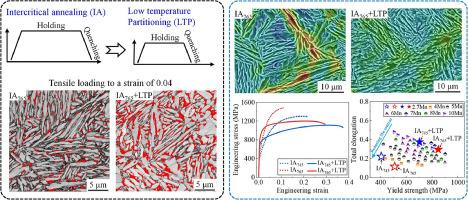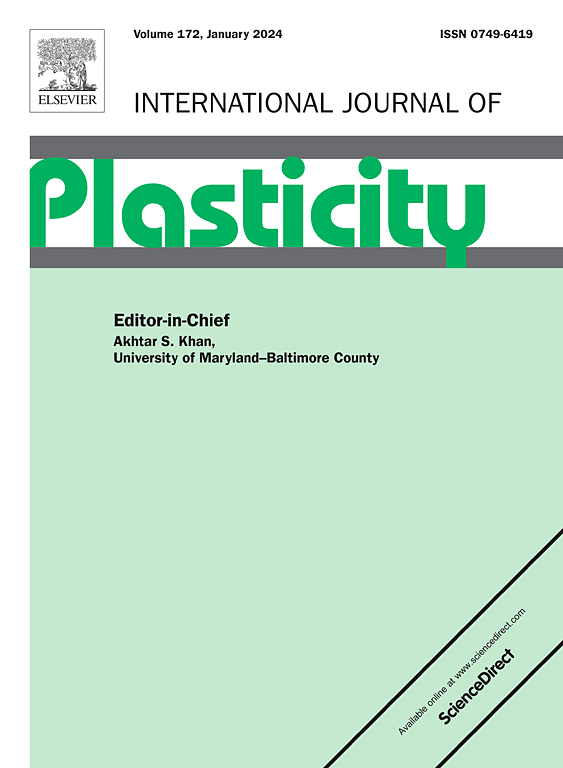通过两步分区热处理提高 2.7Mn 钢的延展性和屈服强度
IF 9.4
1区 材料科学
Q1 ENGINEERING, MECHANICAL
引用次数: 0
摘要
由于还原奥氏体的热稳定性不足,新鲜马氏体(FM)经常出现在中锰钢中,尤其是在锰含量较低的情况下。本文通过两步分区热处理(即临界退火(IA)后的低温分区(LTP)),在含 2.7Mn 的 Al/Si-added 中锰钢中实现了高延展性和高屈服强度。我们的研究表明,在临界退火过程中,C 原子和 Mn 原子从预淬火马氏体分割到回复奥氏体;铝的加入减小了回复奥氏体的尺寸,并通过减慢其生长动力学促进了回复奥氏体中 C 原子和 Mn 原子的富集。这使得还原奥氏体的热稳定性更高,从而减少了调质奥氏体的数量,增加了室温下保留奥氏体(RA)的数量和机械稳定性。在 LTP 过程中,伴随着位错的恢复以及 Al 和 Si 对碳化物析出的抑制,C 原子进一步从 FM 向 RA 分裂,这使得 RA 的机械稳定性更高,从而使高应变硬化持续到更大的应变。同时,由于 C 原子耗尽和位错恢复,FM 的硬度和脆性降低,从而减轻了应力/应变局部化,有利于产生均匀的塑性变形。此外,伴随着位错恢复而出现的移动位错密度降低被认为是钢屈服强度提高的主要原因。本研究结果表明,IA 过程中的一次元素分区(由 Al 促进)和 LTP 过程中的二次元素分区(由 Al 和 Si 促进)以及位错恢复的协同效应,前者提高了还原奥氏体的热稳定性,后者提高了 RA 的机械稳定性和塑性变形的均匀性,从而显著提高了低锰含量中锰钢的韧性和屈服强度。本文章由计算机程序翻译,如有差异,请以英文原文为准。


Enhancing the ductility and yield strength of 2.7Mn steel via two-step partitioning heat treatment
Fresh martensite (FM) is often present in medium-Mn steels, especially when containing lower Mn content, due to the insufficient thermal stability of reverted austenite; this FM is brittle, largely deteriorating the ductility. In this paper, large ductility and high yield strength are achieved in an Al/Si-added medium-Mn steel containing 2.7Mn via a two-step partitioning heat treatment, i.e. intercritical annealing (IA) followed by low-temperature partitioning (LTP). We show that, during the IA, C and Mn atoms partition from the pre-quenched martensite to reverted austenite; Al addition reduces the size of reverted austenite and promotes C and Mn enrichment in the reverted austenite by decelerating its growth kinetics. This enables the reverted austenite more thermally stabilized, thereby reducing the amount of FM and increasing the amount and mechanical stability of retained austenite (RA) at room temperature. During the LTP, accompanied with the recovery of dislocations and the suppression of carbide precipitation by Al and Si, C atoms further partition from FM to RA, which enables the RA more mechanically stabilized and thereby sustains the high strain hardening to larger strains. Simultaneously, the FM becomes less hard and less brittle due to C atoms depletion and dislocations recovery, alleviating the stress/strain localization and favoring the uniform plastic deformation. Furthermore, the decrease in mobile dislocation density that is accompanied with the recovery of dislocations is believed to be mainly responsible for the enhanced yield strength of the steel. The present results indicate that the synergetic effects of the primary element partitioning (promoted by Al) during IA, which increases the thermal stability of reverted austenite, and the secondary element partitioning (enhanced by Al and Si) and as well dislocation recovery during LTP, which increases the mechanical stability of RA and the uniformity of plastic deformation, significantly enhance both the ductility and yield strength of medium-Mn steel with low Mn content.
求助全文
通过发布文献求助,成功后即可免费获取论文全文。
去求助
来源期刊

International Journal of Plasticity
工程技术-材料科学:综合
CiteScore
15.30
自引率
26.50%
发文量
256
审稿时长
46 days
期刊介绍:
International Journal of Plasticity aims to present original research encompassing all facets of plastic deformation, damage, and fracture behavior in both isotropic and anisotropic solids. This includes exploring the thermodynamics of plasticity and fracture, continuum theory, and macroscopic as well as microscopic phenomena.
Topics of interest span the plastic behavior of single crystals and polycrystalline metals, ceramics, rocks, soils, composites, nanocrystalline and microelectronics materials, shape memory alloys, ferroelectric ceramics, thin films, and polymers. Additionally, the journal covers plasticity aspects of failure and fracture mechanics. Contributions involving significant experimental, numerical, or theoretical advancements that enhance the understanding of the plastic behavior of solids are particularly valued. Papers addressing the modeling of finite nonlinear elastic deformation, bearing similarities to the modeling of plastic deformation, are also welcomed.
 求助内容:
求助内容: 应助结果提醒方式:
应助结果提醒方式:


